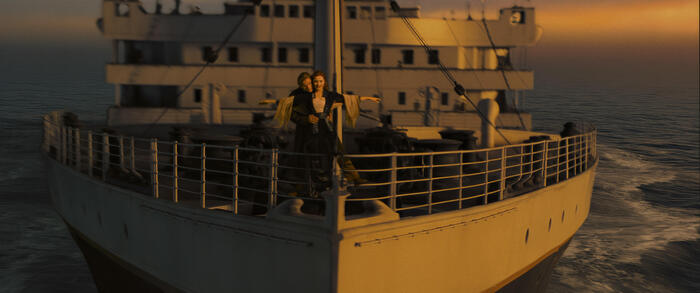On the night between 14 and 15 April 1912, the fastest and most majestic ocean liner of the 20th century, RMS Titanic, sank in the waters off the coast of Newfoundland following a crash into an iceberg floating in the North Atlantic Ocean. Of the 2223 passengers only 705 escaped death, while others died on board the rescue ships. The most famous disaster in the history of modern shipping has always fascinated cinema, especially because until 1985 no one had traced the wreck with certainty.
The exploration of the ship hunter Robert Ballard pushed, 10 years later, the director and oceanographer James Cameron to go to the bottom of the ocean to shoot a documentary on that story and from there the idea of including a great love story was born against the backdrop of the real reconstruction in the shipwreck.
Thus was born the myth of the film "Titanic" with Leonardo DiCaprio and Kate Winslet in the roles of Jack and Rose, the unfortunate lovers separated in the end at the bottom of the sea, a legend mixed with truth that Rose tells to the treasure hunter Brock Lovett thus reviving to the viewer the tragedy of that night and the spectacular reconstruction by a true expert that James Cameron offers us. Result? Record number of Oscar nominations (14) and statuettes won (11), as well as one of the five highest grossing entries in the history of cinema.
But the story of the largest ocean liner in the world actually began on the screen already in the autumn of 1912 when two short films inspired by the disaster were released, one American and the other German: "Saved from the Titanic" by Etienne Arnaud (a woman!) and "In Nacht und Eis" by and with Mime Misu, full of special effects that left spectators of the time breathless.
After Denmark ("Atlantis by August Blom, 1913) it was the turn of Great Britain in 1929 with "Atlantic" by Ewald André Dupont from a theatrical piece and shot in four languages for the different markets (with a subsequent Danish version of the year later).
A separate chapter would deserve the Nazi propaganda film "The Tragedy of the Titanic" by Herbert Selpin and Werner Klingler in which an officer and the German passengers on board heroically succumb, victims of the ruthless cynicism of the capitalist and Albion shipowners who defied the sea and nature.
After the war it would take several years for the Titanic to come back into fashion. It would happen in 1958 with "A night to remember" by Roy Ward Baker while it was the turn of the Englishman Willian Hale with "SOS".
Titanic" filmed for TV in 1979, the first accurate reconstruction of the events of the fateful night. From here on, with the exception of Bigas Luna's erotic/sentimental digression "The Image of Desire" from '79 in which the theme is only a pretext for the protagonist's imaginary adventures, the famous wreck takes center stage, long considered unrecoverable until James Cameron brings the camera there in the 2003 documentary "Ghosts of the Abyss" (shot in IMAX) while the myth which inspired his blockbuster seven years earlier had already generated "Blitz in the Ocean" by Jerry Jameson from the novel by Clive Cussler in 1980. This was followed by Camillo Teti's uninspired Italian cartoon "Titanic, the legend continues" (2000) , even the B Movie "Titanic 2" by Shane Van Dyke with which Cameron wants nothing to do. But the brilliant director/explorer still recently left a glimmer of hope for the possibility of returning aboard the wreck with the bathysphere. and the cameras on the edge of a new narrative idea. Because the Titanic is not just a legend of seafaring, but a living warning about the force of nature and the transformations of the planet. And therefore it still arouses nightmares and dreams of a more than current nature.

